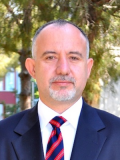Table of Contents
Definition / general | Essential features | Terminology | Epidemiology | Pathophysiology | Etiology | Clinical features | Diagnosis | Radiology description | Prognostic factors | Case reports | Treatment | Clinical images | Microscopic (histologic) description | Differential diagnosis | Additional referencesCite this page: Özer E, Borys D. Skeletal dysplasias. PathologyOutlines.com website. https://www.pathologyoutlines.com/topic/boneskeletaldysplasias.html. Accessed April 3rd, 2025.
Definition / general
- Skeletal dysplasias are a heterogeneous group of conditions associated with abnormalities of the skeleton, including abnormalities of bone shape, size and density, that manifest as abnormalities of the limbs, chest or skull
- The latest classification lists 456 disorders under 40 group headings differentiated by specific clinical, radiographic and molecular criteria (J Back Musculoskelet Rehabil 2015;28:575)
- The 4 most common conditions are thanatophoric dysplasia, achondroplasia, osteogenesis imperfecta and achondrogenesis
Essential features
- Skeletal dysplasias differ in natural histories, prognoses, inheritance patterns and etiopathogenetic mechanisms
Terminology
- Osteochondrodysplasias
Epidemiology
- The prevalence of skeletal dysplasias (excluding limb amputations) is estimated at 2.14 per 10,000 births (Am J Med Genet 1996;61:49)
- Males are primarily affected in X linked recessive disorders; otherwise, males and females are usually equally affected
Pathophysiology
- Based on the underlying molecular genetic cause, the dysplasias can be broadly grouped by the function of the protein product of the causative gene
- Many of the genes mutated in skeletal dysplasias encode proteins that play critical roles in the growth plate
- Radiographics 2008;28:1061
Etiology
- FGFR3 gene mutation causes achondroplasia, hypochondroplasia and thanatophoric dysplasia
- Mutations in the procollagen I genes (COL1A1, COL1A2) cause various types of osteogenesis imperfecta
- Mutations in the diastrophic dysplasia sulfate transporter gene (DTDST) cause diastrophic dysplasia, achondrogenesis type IB and atelosteogenesis type II
- Mutations in the procollagen II gene (COL2A1) cause achondrogenesis type II
- SOX9 gene mutation causes campomelic dysplasia
- J Back Musculoskelet Rehabil 2015;28:575
Clinical features
- Typically presents with disproportionate short stature in childhood or premature osteoarthritis in adulthood
- In addition to the skeletal disorder, individuals frequently demonstrate abnormalities of hearing, vision, neurological, pulmonary, renal or cardiac function
Achondrogenesis
- Type I:
- Rare, lethal
- Extreme limb shortening
- Marked discrepancy between head and trunk size
- Severely delayed ossification
- Type IA:
- Autosomal recessive
- No ossification of vertebral pedicles
- Rib fractures
- Chondrocytes have inclusion bodies, but cartilage matrix is near normal
- Type IB:
- Distinctly abnormal cartilage matrix with rarefaction of ground substance and peculiar ringlike pericellular arrangement of collagen fibers
- Lethal osteochondrodysplasia due to mutations in transporter gene for diastrophic dysplasia sulfate
- Genetic defect causes complex derangement in cartilage matrix assembly
- Impaired decorin deposition causes lack of development of normal interterritorial matrix, preventing necessary structural substrate for proper endochondral bone formation and severe skeletal phenotype
- Reference: Emedicine: Achondrogenesis
Achondroplastic dwarfism
- Major cause of dwarfism
- Reduction in chondrocytes at growth plate is due to defect in fibroblastic growth factor receptor 3 gene (FGFR3)
- FGFR3 inhibits cartilage proliferation, and is constitutively active in these patients
- Autosomal dominant, but 80% of cases are new mutations
- Clinical image
- Clinical features:
- Short proximal extremities, normal trunk, enlarged head (bulging forehead, depression of root of nose)
- Normal intramembranous bone formation, so bone cortices seem thickened compared to short bone length
- Normal life, IQ, reproductive status
- Micro description: narrow / disorganized zones of proliferation and hypertrophy in growth plates; chondrocytes in clusters, not columns; base of growth plate has prematurely deposited struts of bone which seal the plate
Thanatophoric dwarfism
- Also called thanatophoric dysplasia
- “Thanato”: denoting death
- Lethal form of dwarfism
- Occurs in 1 per 20,000 live births
- Case report: variant in 18 week male fetus (Arch Pathol Lab Med 1993;117:322)
- Micro description: diminished proliferation of chondrocytes and poor columnization of zone of proliferation
Diagnosis
- Prenatal evaluation of skeletal dysplasias includes a detailed ultrasound of the fetal skeleton in the second or third trimester of gestation and an extensive genetic family history work up
- Low dose fetal CT is a powerful imaging tool that aids in diagnosing skeletal dysplasias (Radiographics 2008;28:1061, AJR Am J Roentgenol 2013;200:989)
Radiology description
- No single unifying features exist; referring to the specific types of skeletal dysplasia for individual features is recommended (World J Radiol 2014;6:808, Radiographics 2008;28:1061)
- Thanatophoric dysplasia is associated with:
- Polyhydramnios
- Thickened soft tissues
- Micromelia
- Extremities at 90° to trunk
- Bowed femur (telephone receiver)
- Platyspondyly
- Frontal bossing, depressed nasal bridge
- Cloverleaf skull (type II)
- Achondrogenesis is associated with:
- Polyhydramnios
- Thickened soft tissues
- Micromelia
- Absent ossification of vertebral bodies
- Normal calvarial ossification (type II)
- Small thorax, some with rib fractures (type IA)
- Osteogenesis imperfecta IIA is associated with:
- Asymmetric micromelia
- Irregular / thickened bones
- Angulated bones
- Beaded ribs, small thorax
- Poorly ossified skull
- Osteogenesis imperfecta IIB is associated with:
- Lower extremities more affected
- Less beading of ribs
- Poorly ossified skeleton
- Osteogenesis imperfecta IIC is associated with:
- Thin bones, multiple fractures
- Thin beaded ribs
- Poorly ossified skull
- Achondroplasia is associated with:
- Rhizomelia, mild mesomelia
- Stubby fingers
- Frontal bossing
- Narrowed interpediculate distance
Prognostic factors
- The prognosis is widely variable, ranging from very mild cosmetic deficits to being lethal
- Thanatophoric dysplasia and achondrogenesis account for 62% of all lethal skeletal dysplasias
- Achondroplasia is the most common nonlethal skeletal dysplasia
Case reports
- Child with consanguineous (first cousins) parents and type IB (Arch Pathol Lab Med 2001;125:1375)
Treatment
- Treatment is supportive
- Mild cosmetic deficits can be treated surgically
Clinical images
Microscopic (histologic) description
Achondrogenesis
- Abnormal endochondral bone formation with curved cartilage-bone junction at growth plates, periosteal bony spurs
- Sponge-like cartilage matrix due to lack of interterritorial matrix
- Epiphyseal cartilage composed of multiple discrete units of chondrocytes encased in territorial capsule and separated from each other by clefts containing fibroblast like cells
- Mosaic of chondrocyte units (chondrons) due to breakdown of usual matrix continuity of epiphyseal cartilage
Differential diagnosis
- CHARGE syndrome
- Apert Syndrome
- Cornelia De Lange Syndrome
- Cystinosis
- DiGeorge Syndrome
- Down Syndrome
- Fanconi Syndrome
- Hyperparathyroidism
- McCune-Albright Syndrome
- Cytomegalovirus infection
- Sialidosis (Mucolipidosis I)
- Trisomy 18
Additional references






